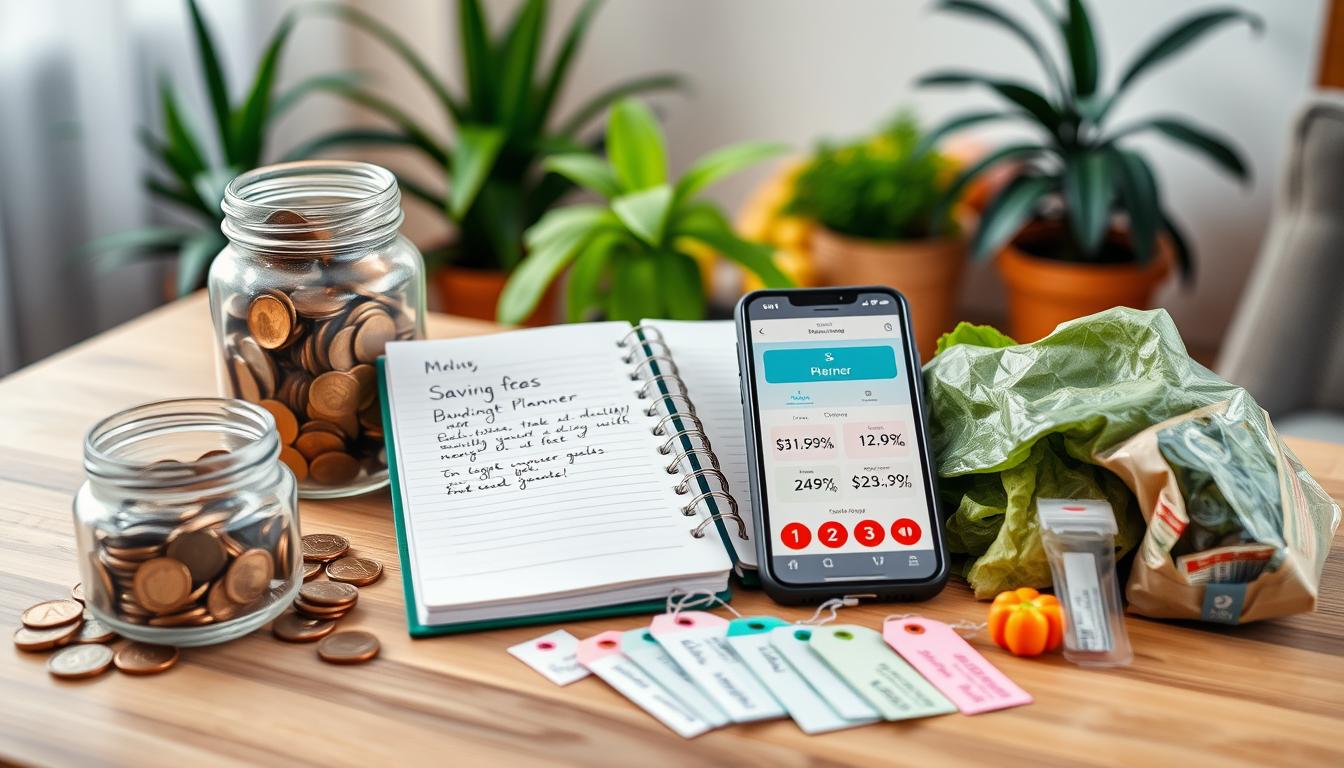Did you know that 59% of Americans enjoy saving more than spending? However, many find it hard to save money. This shows a big chance for effective saving during financial difficulties1. About 38% of Americans say they have less than $1,000 saved up1. So, using smart money-saving tips is very important. In this article, I’ll share five strategies I tested myself to improve my finances.
Setting financial goals is key today. It’s important to know how to handle your budget well. This article will give you tips to help start saving now. So, stop spending too much, and let’s hit those financial goals together!
Key Takeaways
- 59% of Americans prefer saving over spending.
- 38% have less than $1,000 saved for emergencies.
- Utilizing effective budgeting strategies can significantly boost savings.
- Implementing practical money-saving tips can yield positive financial results.
- Tracking your expenses is crucial for better money management.
The Importance of Saving Money
Knowing why saving money matters is crucial for everyone aiming for financial security. A good savings plan helps cover emergency funds. It also sets you up for success now and in the future, like for retirement planning. An average person spends about $3,639 a year on eating out. Imagine saving by eating in more often2. Small steps in saving, like the “Invisible Savings” method, can add up. Saving a few dollars every day can turn into over $1,000 in a year3.
It’s also key to have long-term savings for big costs or unexpected money issues. Making a budget tracks spending and encourages smarter money choices. This can boost your savings4. Many people forget how stopping unnecessary subscriptions can free up money for savings. Also, sharing rides or using cash-back apps helps save without changing your lifestyle much.
Saving money moves you from just getting by to having extra for surprises. This secures your financial health now and ahead. Getting and sticking to these saving tips means facing money needs calmly.
Understanding Your Current Spending Habits
Understanding how you spend money is the first step to better financial health. By keeping track of your expenses, you see where your money goes. This helps you spot where you can save more. Using budgeting apps or spreadsheets makes sorting your spending easy.
Tracking Your Expenses Effectively
Start by following the 50/30/20 budget rule suggested by experts. This means you spend 50% of your money on needs, 30% on wants, and save the rest, 20%. Reviewing your expenses regularly helps you spot and cut unnecessary spending5. Automated transfers can help save money without thinking about it5.
Identifying Areas for Improvement
Set clear, achievable financial goals for both the near and distant future. A short-term goal could be building an emergency fund. This helps you prepare for unexpected expenses. A long-term goal might be saving for a house5. Try fun savings challenges to mix things up and save more than $1,378 in a year5. You can also cut costs by finding ways to save on bills or by renegotiating your cable plan, leading to big savings over time6.
![]()
Money-Saving Mind Games That Work
Knowing how you think about spending can reveal a lot about your money habits. Trying certain mental tricks can shape the way you save. Say you’re about to buy something big. First, take some time to think it over. This pause helps you decide if it’s really worth it, often saving you money.
Picture the long-term benefits versus the short-term pleasure of spending. Imagine turning $1,000 into much more over a few years. Understanding this can help you control spending. Small psychological changes can improve your saving habits greatly. This helps you save more money in the long run.
Testing different saving methods can change how much you save7. For example, using the cash envelope system, people saved £37.50 more. And by choosing a bank with better rewards, you could save up to £575 a year8. Expense tracking apps highlight areas where you spend too much, leading to smarter choices.

| Method | Potential Savings | User Rating |
|---|---|---|
| Cash Envelope Method | £5160 in a year | 3/5 |
| Switching Banks | £575 annually | 2/5 |
| 100 Envelope Challenge | £5,050 in a year | 2/5 |
| Round Ups | £28.68 in a week | 4/5 |
| No Spend Challenge | £1800 in a year | 4/5 |
Using these techniques daily helps you think differently about spending and saving78. It completely changes your financial mindset.
I Tried These 5 Money-Saving Tips—Here’s What Actually Worked!
Using mental tricks during big buys boosts your impulse control. Focusing on future benefits instead of quick joy helps you prefer saving. For example, it’s smarter to invest your money than to spend it on the latest gadget.
Mind Games with Large Purchases
Think about the long-term effects before you buy something big. Necessities take up about 55% of our income. It’s crucial to use our money wisely. Using psychological spending tricks can help. Imagine turning $1,000 saved now into much more later.
Envisioning Future Gains vs. Immediate Gratification
Getting on track financially takes discipline. Putting that $1,000 into savings or investments could mean big rewards later on. It boosts your financial health. Every time you skip a purchase, you’re building a stronger financial base. This approach matches well with money-saving strategies. It keeps you from buying on a whim.

By focusing on these strategies, you take control of your finances. You’re not just saving; you’re investing for the future. These steps show that decisions made today affect your success tomorrow910.
Letting Small Sums Accumulate
Starting with small savings can lead to big rewards over time. By regularly setting aside little amounts, your finances can grow impressively. It can be as simple as skipping a daily coffee or saving a few dollars each week. These small steps help develop strong savings habits.
The “Small Savings” Approach
Many overlook the power of small financial choices. Yet, they can lead to big incremental savings. Imagine setting aside $5 with each laundry cycle. This small action adds up fast. It’s amazing how minor spending adjustments can accumulate into large amounts over a year.
Examples of Incremental Savings
- Cutting out a daily coffee can save almost $1,000 a year. This shows the impact of minor changes.
- Using savings jars for different goals helps you see your saving progress clearly.
- Earning discounts through loyalty programs or cash-back credit cards boosts your savings.
- Meal prepping instead of eating out reduces your monthly bills significantly.
- Using clothing rental services offers stylish choices without the big expense.

Adding these smart saving methods makes reaching financial goals easier.
Making Phone Calls to Save Money
Starting to negotiate bills can be as simple as making a phone call. Many customers don’t realize how effective this approach can be. By contacting service providers, you can unlock phone call savings. For example, making these calls can save you an average of $83.33 per call14. This can lead to a total monthly saving of about $500. This includes savings from utility, cell phone, and car insurance companies14.
The timing of your call plays a big role in successful negotiations. Negotiating bills is often more fruitful at the year’s end or during sales events like Black Friday or back-to-school15. Staying informed about competitor prices can also strengthen your position. This knowledge encourages providers to offer you better rates to keep your business15.
Some companies give discounts based on age, starting at 55, and offer savings for using paperless billing15. If you meet resistance when negotiating, keep pushing15. Don’t be afraid to request a supervisor if the initial representative can’t meet your needs15.
Other ways to save include making your lunch instead of eating out16. This alone can save you up to $1,250 every year16. Reducing unnecessary subscriptions can save about $50 monthly16. By tracking your spending, you can pinpoint where to cut costs. Taking detailed notes from each call helps you evaluate your options. This lets you make informed decisions after negotiating new terms with your providers15.

| Service Provider | Monthly Savings |
|---|---|
| Cable provider | $45 |
| Utility provider | $60 |
| Cell phone provider | $50 |
| Car insurance provider | $100 |
| Spa cancellation | $45 |
| Bank transaction limits | $200 |
| Total Savings | $500 |
Automating Your Savings: A Hassle-Free Method
Setting money aside is easier with automation, enhancing your financial wellbeing. Financial tools let you save without much thought. Automated savings methods, like direct deposits, work well. They move money from checking to savings accounts, growing your funds with each deposit.

The Benefits of Automated Savings
Automated savings can grow your money over time. For example, saving $300 a month adds up to $3,600 a year. This process removes the stress of deciding to save and helps you meet your goals17. It also stops you from spending money on a whim, by setting it aside first18.
Also, you can change your saving amount as your life and goals shift19. Over time, these small steps can greatly increase your financial security. This makes saving both simple and effective.
Matching Spending with Savings
Making your spending match your savings leads to better financial health. By doing this, you become responsible for how you spend money. For example, put the same amount of money you spend on fun things into your savings. This practice helps you keep expenses and savings balanced. It also cuts down on spending too much.
Turning Costs into Savings
Starting money-saving challenges can improve how you handle money. The 52-Week Money Challenge lets you save up to $1,378 a year by setting aside $1 to $52 each week20. Then there’s the Daily Nickel Challenge. By saving just an extra 5 cents daily, you can have over $3,300 by year’s end20. These methods improve your spending habits and reward you for saving.
Using automatic transfers to your savings makes saving easier21. For each impulse buy, try fun savings games like the Roll-the-Dice Challenge. This mixes fun with financial planning, saving whatever number you roll daily20. By recognizing unnecessary expenses, like too many magazine orders, you’ll see big savings. This way, you’re really paying attention to where your money goes.

Conclusion
Adopting effective saving tips can really shape your financial life. Spotting where your money goes and fighting off spur-of-the-moment buys are great steps. Putting away even tiny amounts in a savings account works wonders over time. This approach could save you over $5,700, just by being disciplined22.
Talking through bills on the phone and setting up automated savings streamline your plan. Also, planning your meals, using cash-back apps, and cutting off unneeded subscriptions help a lot23. These tips underline how critical managing finances is for reaching bigger goals.
Staying consistent is crucial. By following these tips and favoring savings over extras, your financial health improves. Plus, small cutbacks now lead to big gains later24.








